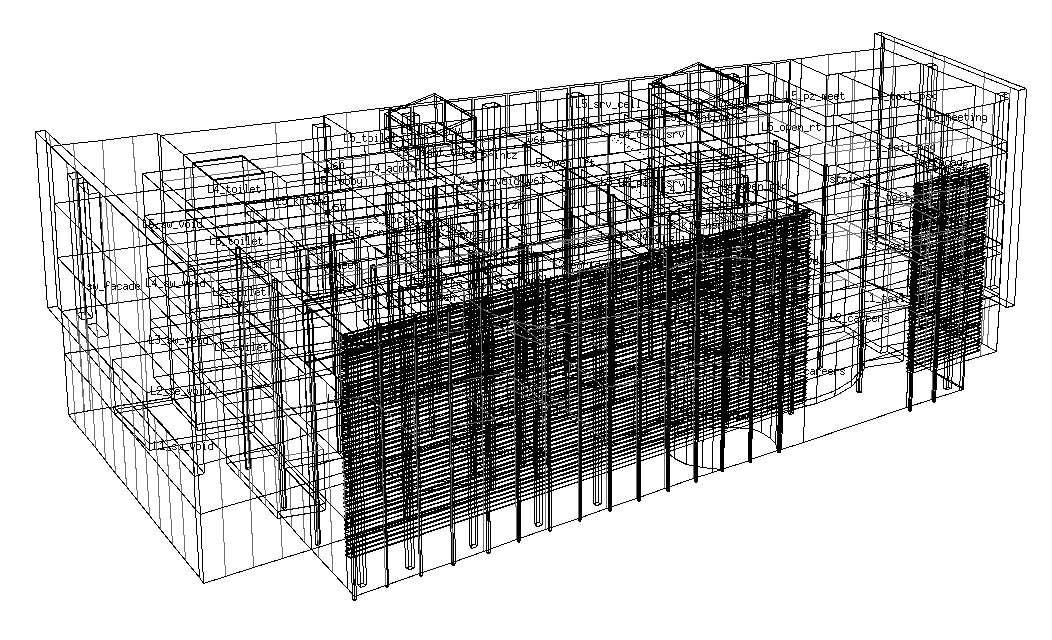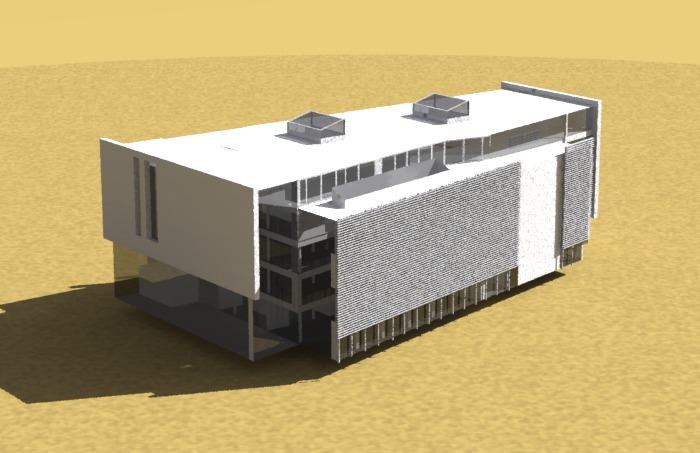Shading calculations
In ESP-r shading and insolation calculations were included from the outset. At that time the goals were to ensure high integrity modelling and solar distributions were no more or less important than other contributions to zone and surface energy balances. Since that time the interface and facilities have evolved for example to include diffuse shading and to generalise geometric transforms.
Models include site location attributes (latitude and longitude) at the origin of the model coordinate system. All surfaces and shading entities use site coordinates. If a real building is at 59m elevation it can be literally defined, however most users would probably assume street level is near zero height. Users have the option to accept the latitude and longitude of the weather data file or to nominate a variant latitude and longitude.
In ESP-r facades (glass, frames, reveals, walls, roofs) are zone surfaces. The associated polygons can take any arbitrary form as long as they follow the general rules for polygons. Thermal zones must be fully bounded and can take any arbitrary shape, including wholly or partially enclosing other thermal zones. Glazing need not be a child surface of an opaque facade surface.
In ESP-r the default assumption is an unobstructed site, surfaces not facing the sun are in shadow. An expert over-ride allows users to define one or two surfaces to accept all incoming insolation but the usual approach is to pre-calculate shading and insolation patterns.
Shading calculations make use of geometric bodies called solar obstructions to represent other buildings, landforms, overhangs, fins and reveals:
Roughly 100 blocks or bodies per zone are allowed. The geometric scale of blocks or bodies is determined by the user. For example, exterior blinds can be created from multiple solar obstructions. Urban streetscapes or trees can be created from multiple blocks and bodies. Within a given model solar obstruction are fixed (they cannot be moved or rotated during a simulation). Seasonal effects require alternative models to be created either with different opacity attributes or geometric attributes.
These obstruction bodies are also passed to Radiance for visual assessments. In the figure below a external shading scheme has been rendered in Radiance to help a client understand the underlying patterns of shade and shadow used during the assessment.
 see full size
see full size
 see full size
see full size
In ESP-r shading (and insolation) calculations are pre-calculated via the ish module based on the form and composition of zones, obstructions and directives held within the model files. Ish uses a gridding approach to resolve direct and diffuse shading on facades. Each surface is gridded and each grid point is tested to see if direct or diffuse solar radiation is blocked by the zones associated obstruction blocks or bodies (or if the surface is facing away from the sun). The default grid resolution tends to work well unless surface polygons include small dimensions (i.e. a frame 10mm wide). Increasing gridding usually resolves this at some computational expense. Diffuse shading is based on a sky vault with 145 points.
Reflection off of facade surfaces is not tracked by default, but can be enabled via joint use of Radiance and the shading utility ish.
Optical properties for each type of glazing are gathered from .... and control logic from ..... is applied.
Directives
Currently the frequency of shading and insolation calculation is hourly during sun-up hours for a typical day in each month. Users can request calculations to be carried out over the year or a portion of the year.
The level of resolution of solar distribution is dependent on the level of geometric resolution within the zone and the grid resolution. If, for example, the floor of a room is subdivided each is separately considered. If a surface representing a frame has small dimensions it may be necessary to increase the grid resolution.
Constraints
As long at the surfaces in the zones are recognised as fully bounded and the zone is fully bounded calculations can proceed. If no glazing is found in the zone insolation calculations are not carried out. If there are no obstructions defined or no surfaces with an outside boundary condition shading calculations are not carried out.
Computing resources
In ESP-r establishing shading and insolation patterens for each hour for a typical day in each month is in the order of seconds. Computational demands increase roughly linearly with an increase in the number of obstructions or insolation sources. At the limits of zone complexity a minute might be required (unless graphic feedback of insolation patterns is requested).
Back to top | Back to Welcome page